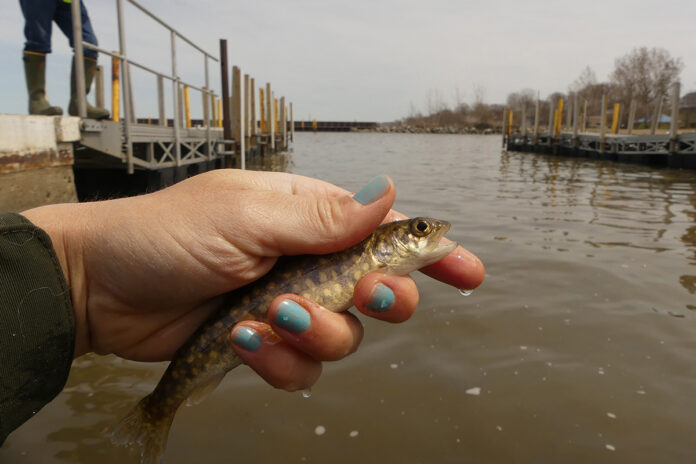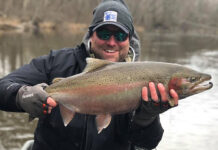
Native to the Great Lakes, lake trout were once the apex predators of Lake Erie, especially in the eastern basin that provides the deep, cold water that they need. With a lifespan of 30 years and a potential weight of 50 pounds or more, their dominance remained unchallenged.
Until, that is, commercial fishing began in the 1700s. When gill nets and deep-water fishing boats were added in the 1800s, yearly harvests of lake trout were in the tens of thousands of pounds by the dawn of the 20th century.
Pollution from growing cities, factories and mines and excessive nutrients from farms and untreated sewage began to ruin the clean, rocky bottoms the lake trout need for spawning. Then, the invasion of the sea lamprey seemed to seal their fate.
The sea lamprey probably entered the Great Lakes through the Erie Canal, and then overpopulated after the completion of the Welland Ship Canal in 1932. The eel-like creatures latch onto adult trout — targeting those over 29 inches — and suck blood and tissue until the fish becomes too weak to be a useful host.
Task group
The combined factors of pollution, overfishing and parasites are believed to have eliminated lake trout from Lake Erie by 1965, said John Deller, fisheries biologist with the Ohio Division of Wildlife’s Fairport Fish Research Unit. He is also co-chair of the Lake Erie Coldwater Task Group, formed in 1985 under the Lake Erie Committee of the Great Lakes Fish Commission.
The task group includes representatives of the Pennsylvania Fish and Boat Commission and state and federal agencies from the United States and Canada, New York and Michigan. The task group coordinates yearly assessments in the eastern basin and reports on “the status of the coldwater fish community.” They help with control of the sea lamprey in Lake Erie and keep track of “salmonid” fish stocking, including lake, brown and rainbow trout.
They are also in charge of carrying out the lake trout management plan approved a year ago.
“Our goal is to re-establish the population and natural reproduction,” Deller said.
Strategic stocking
Step one is maintaining the adult population at the current levels, which is done by strategic stocking of yearling lake trout. Since stocked fish usually return to the same areas to spawn, it’s important to make sure there is good breeding habitat where the fish are released.
Early efforts at stocking had lake trout released on the U.S. side of Lake Erie’s eastern basin, which is bordered by New York and Pennsylvania but not Ohio. The area from Presque Isle to Buffalo, N.Y., includes the deepest and coldest parts of the lake, Deller explained.
Searching for good habitat where released lake trout could return to spawn, the task group decided to expand stocking to the central basin at Fairport Harbor. The harbor’s reefs and breakwalls offer clean, rocky bottoms free of aquatic vegetation and zebra mussels.
Until 2021, about 80,000 lake trout were released each year off the shores of New York, and another 80,000 from Pennsylvania, leaving only 40,000 a year for Fairport Harbor. Under the new management plan, 120,000 were released in Fairport Harbor last year, while 80,000 were released there in April of this year.
Next year, the number released there will be zero. Why? In their studies, the task group realized that releasing the same number of fish in the same place every year allowed gulls, walleye and other predators to detect a pattern and show up for the banquet.
The new plan puts the releases on a three-year cycle; the year when none are released throws the predators off, Deller said.
Fairport Harbor

The choice to release lake trout in Fairport Harbor appears to be a good one. The U.S. Geological Survey and the U.S. Fish and Wildlife Service were actually looking for whitefish eggs in their survey last November and December. But they also found lake trout eggs right off the Fairport Harbor shore, proof that they are spawning there.
“We knew they were returning to Fairport Harbor and spawning because anglers were catching them there,” Deller said.
The lake trout released into Fairport Harbor and the eastern basin are always yearlings because they have a better survival rate than younger fingerlings, he said. They all come from the U.S. Fish Hatchery in Allegheny, Pa.
Before they’re released, the fingerlings are given a small, coated wire tag and one of their fins is clipped. If they’re caught in future surveys, biologists know when they were stocked, and where.
There is a kink in the repopulation plan that the coldwater task group has had to learn to live with: It takes lake trout half a decade before they’re old enough to reproduce.
“They don’t mature till at least age five, so it takes five years to see results from the things we try,” Deller said.
Early stocking efforts didn’t see many living to maturity, but that is changing, he said. Of the 217 lake trout collected in the Coldwater Assessment Survey last year, adults ages 5, 6, 9 and 11 were the most numerous. Plus, lake trout ages 10 and older “continue to increase in abundance” and made up 35% of the total catch, the report said.
The agencies stocking lake trout have tried using different strains over the years. Those whose parents came from the Finger Lakes in New York, or from Lake Champlain, which spans New York and Vermont, have the best survival rates, the task group concluded.
Under the new plan, the population will be assessed every year through 2030 to see if the stocking regime is working.
“We’re letting the lake trout show us where they’re going,” Deller said. “If we find that spawning habitat has been compromised by zebra mussels or vegetation, we can create new habitat or clean out the old habitat.”
In that case, the goal of maintaining the adult population and getting them to reproduce naturally will have been achieved, he said.
“We’re just starting to get to the point where we think they can pull it off.”












